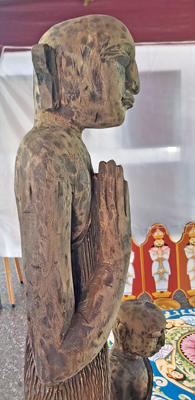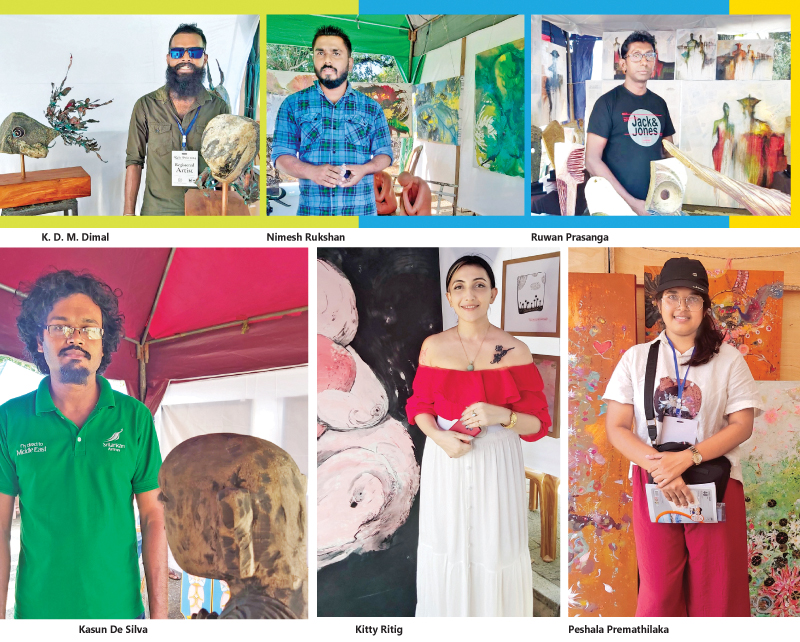“An artist should never be a prisoner of himself, prisoner of style, prisoner of reputation, prisoner of success.” Henri Matisse is supposed to have said. As someone who believes that art could be a catalyst to attain freedom of heart and mind, even momentarily, this quote stays with me.
I think I have a legitimate right to believe and declare that art does pave way for freedom of thinking, as that has been my personal experience. It is because of that belief that I make art, view art and write about art. I believe that art can psychologically and emotionally unshackle us, and in doing so, art could make us more resilient, strong, courageous and above all, hopeful.
If I were to witness what art means to artists and artisans, even more so than to viewers or an audience, I thought Kala Pola would be the ideal place for me to be at. It is with this aspiration that I visited Kala Pola last week. If there is one event which provides artists from all over the island an opportunity to display their work, that would be the Kala Pola which is held annually along the Green Path for a day. As envisaged, I met several artists whose work would give meaning to the purpose of art.
I could see that Peshala Premathilaka, who established her career an abstract artist, had moved on to more figurative depictions. Her dream-like, colourful paintings reminded me of illustrations in Russian and Chinese books which awed me as a child.
 “My art is inspired by my life experiences, natural beauty that surrounds me and my vivid imagination. I find that my best work comes from a place of deep personal connection, and I strive to create pieces that are both aesthetically pleasing and emotionally resonant,” Peshala explains.
“My art is inspired by my life experiences, natural beauty that surrounds me and my vivid imagination. I find that my best work comes from a place of deep personal connection, and I strive to create pieces that are both aesthetically pleasing and emotionally resonant,” Peshala explains.
Paintings of Kitty Ritig, the multi disciplinary visual artist, have a unique identity. She describes them as an invitation to the audience to ‘embrace their inherent softness fostering a sense of belongingness and contemplate their relationship with the Creator and the significance of being unconditionally loved.’ Kitty’s pastel coloured palette and subtle, curved lines convey her voice well.
Traditional patterns
I was intrigued by the works of the artisan Kasun De Silva from Ambalangoda. Kasun’s work were wood sculptures and traditional Sri Lankan patterns painted on wood. Although there was no underlying concept, Kasun’s work was aesthetically appealing. When asked where he learnt his craft, he said it was from the artisans and craftsmen of his village in Ambalangoda which is renowned for traditional mask making and wood crafts.
Dileepa Lakshitha, a final year student of the UVPA, had displayed a kinetic sculpture which I felt was a novel attempt to elevate sculpture to an arena which is minimally explored in the Sri Lankan context. The moving sculpture titled ‘Love’ depicted abstracted male and female forms which would merge and separate from time to time. Sharing the same stall was K.M.Dinesh Manushka, a third year UVPA student who had experimented with diverse sculptural techniques and mediums such as cement mixed with stones, metal and wood. The works of these two young sculptors indicated the desire of a new generation of sculptors to experiment with new techniques and mediums.
Another versatile sculptor who had experimented extensively with diverse media was Ruwan Prasanga. His sculptural forms were of different kinds of stone, wood, iron, dead coral and mixed media. In addition to sculpture, Ruwan had displayed a series of paintings which he said were explorations of the the 19th century socio-political dynamics of the Kandyan monarchy and the ordinary citizens or the common people of that era.
Fibre casting
Kasun Geethendra, a painter with a unique voice who explores the inner complexities of the human condition had displayed juxtapositions of his somewhat macabre, distorted anatomical depictions with intricate and exquisite technical methods. Kasun states that his intention is to reveal the inner workings of human beings which is very different to the external shell which is exposed to the outer world.
Young sculptor Nimesh Rukshan who graduated from the UVPA in 2022 had showcased a variety of sculptural forms of stone, copper, Nimesh had also explored Fibre casting, Wood sculpture and Assemblage. K.D.M. Dimal who had graduated from the UVPA in 2022, displayed proficiency in working with diverse mediums of sculptural forms. His main forte seemed to be with combining different natural rock formations with copper. The technical proficiency, skill and creativity displayed by both Nimesh and Dimal were notable.
Among more than two hundred stalls, these were just a handful of artists that I had the opportunity to talk to and among those few, I could see that even fewer artists had a clear conceptual basis which underlined their art work. In order to gain more insight on conceptual development in the artistic arena in Sri Lanka, I thought of listening to an interview given by Dr. Priyantha Udagedara, Head of the Department of History and Theory of Arts, Faculty of Visual Arts, UVPA. Although the topic was ‘What is Contemporary Art?’, Dr. Udagedara very aptly initiated the conversation by explaining that a platform such as Kala Pola is for all artists and artisans from varying traditions and disciplines such as traditional, modern, post modern as well as contemporary.
He stressed that there are multiple arguments and discourses as to what contemporary art is and that one of the most significant definitions is that contemporary art should be aligned with the time factor and therefore should be about ‘now’ or the ‘present context’. ‘Context’ seemed to be imperative when determining the nature of contemporary art: in other words the significance of time and space.
“It was the historical occurrences such as the World Wars or Industrialization which led to evolution of art in Europe or the West from Classical to Modernism to Post Modernism to Contemporary. Similarly in Sri Lanka, it was the civil war and the insurgency in the south which took place during the late 1980s which gave birth to what is commonly seen as contemporary art.” Dr. Udagedara elaborated.
Technology
According to Dr. Udagedara, contemporary artists are not necessarily compelled to create an artwork from scratch. On the contrary, a contemporary artist could obtain material or resources which do not belong to him/her in order to convey a concept or a narrative to an audience. “The artwork created may not be long lasting or may not prevail. For example, performance art of Janani Cooray or the ice sculptures by Chamila Gamage which melted within hours in a public area, did not prevail physically or had longevity.
“This is why technology is imperative for contemporary art. Audio visual recordings, or record keeping via other technological means is needed to preserve the artistic process as well as the outcome in order for the narrative to be maintained.
“Another very important aspect about contemporary art is that a distinction cannot be made between good or bad art or high or low art. In Modernism there was a certain disconnection from the economic, socio-political and cultural reality. Contemporary art allows the viewer to give his/her own interpretation to the narrative or the concept that the artist would be conveying,” Dr. dagedara said.
An integral point Dr. Udagedara made was the importance of mainstream and social media in contemporary art: that media has evolved to take form of religion. I ponder on this and realize that media too is a tool of a higher, more powerful entity. An entity which is made of global industrial powers run by a handful of individuals.
As such it would be logical to say that the narratives which contemporary artists may try to convey are also very much influenced by those higher powers. Of course, that is a topic which should be explored separately and much more in depth.
Rare opportunity
For now, I could say as an artist and an art lover that Kala Pola presented a rare opportunity to many in this country not just to enjoy art and be entertained but to educate themselves and broaden their aesthetic and intellectual horizons.
At a time when there is much economic and socio-political calamity or instability, it was invigorating and inspiring to see the resilience and courage so many artists and artisans had displayed with not just their creations and but with the smiles on their faces.
There was a certain current of positivity wafting through Kala Pola: a certain resilience similar to that of those deep rooted, magnanimous trees along the Green Path. It is that unspoken, unidentifiable, energy form which manages to keep us Sri Lankans afloat. I see it as nothing else but ‘Hope’ in its purest form.







